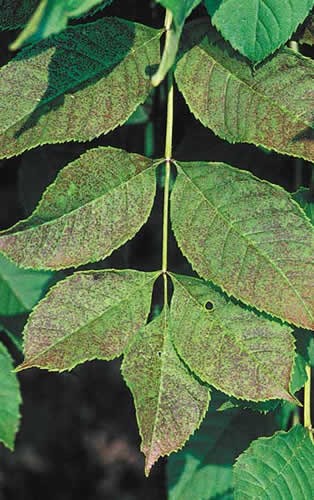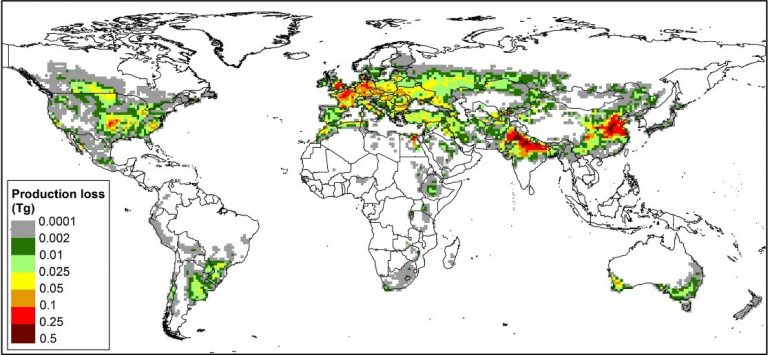The impact of smog on vegetation may have dire consequences for our ability to mitigate climate change – satellite monitoring may hold the key to moderating it
By Jasdeep Anand
If you live in an urban area, you may find that many local trees exhibit some worrying dark spots on their leaves:

Ash leaf showing signs of ozone damage. The dark spots indicate regions where the cells are permanently damaged and are no longer capable of photosynthesis. Source: https://icpvegetation.ceh.ac.uk/get-involved/ozone-injury/about/examples-trees
In many ways, trees are a lot like humans; they prefer warm weather, thrive when hydrated, and do what they are most famous for during the day. However, they are also sensitive to many of the air pollutants that affect our health too. In particular, the spots shown above are due to ozone exposure, and indicate regions where the leaf cells are dead. Why does ozone affect vegetation in this way, and what consequences does this have for our planet?
Ozone and plants
In nature, ozone is a trace gas typically found in the stratosphere, where it performs a critical role in enabling life on Earth by filtering harmful UV radiation. However, in the troposphere ozone is almost entirely the result of man-made emissions, such as nitrogen oxides, carbon monoxide, and volatile organic compounds (VOCs). Ozone is a major component of photochemical smog, which occurs during hot sunny days. Warm temperatures inhibit the movement of air, while sunlight triggers a series of reactions that cause ozone to build up1.
As ozone is a highly reactive gas, it has adverse impacts to health and ecosystems. Exposure to ozone is known to impair lung function and exacerbate respiratory illnesses in humans, especially in children and the elderly2.
Like humans, plants need to exchange gases with the atmosphere, which also puts them at risk of ozone exposure. Once absorbed through the stomata, ozone attacks the plant cells and damages leaf tissue. Damaged leaf cells are no longer capable of photosynthesising, while the leaf also becomes less capable of preventing water loss during heat stress3.
The result of this is twofold; vegetation damaged by ozone are unable to absorb as much carbon dioxide from the atmosphere, impeding growth and seed production, while also aging faster than in ozone-free conditions. Additionally, damaged vegetation are more likely to wilt and die during drought.
Current ozone concentrations across Europe, North America, and China already exceed the capacity of many vegetation species to avoid damage. For instance, in 2011 it was estimated that global ozone-induced crop yield losses were between $11-18 billion4.

Average wheat yield loss due to ozone between 2010-20125
Climate change implications
Ozone is not just a threat to our crops; terrestrial vegetation absorbs approximately 30% of our carbon emissions via photosynthesis6, so the conservation and enhancement of these ecosystems plays a crucial role in our efforts to avoid dangerous climate change over the next century. In fact, two-thirds of signatories to the 2015 Paris Agreement indicated that they would use their ecosystems to meet their emission reduction targets7.
The damage caused by current ozone levels reduces the amount of carbon absorbed by vegetation (gross primary productivity, or GPP) by 5-20%8 over the Eastern United States, Europe, and Eastern China. Over the past few decades, emission control policies such as the EU Air Quality Framework Directive (96/62/EC) have been largely successful in curbing emissions of ozone precursors, leading to lower ozone exposure metrics for most regions9.

Present-day Ozone-induced GPP reductions estimated by the NASA Yale Interactive Biosphere (YIBs) model for the Northern hemisphere. The percentages indicate the relative GPP reduction compared to a control scenario where no ozone was present8.
However, over the next century ozone concentrations are unlikely to fall under all but the most optimistic IPCC emission reduction scenarios10. Future climate changes may also increase the length and severity of summer droughts and heatwaves over some regions, which in turn would increase ozone concentrations11.
Existing measurements and their limitations
Accurate modelling of ozone-induced GPP reductions is therefore essential to determining the capacity of terrestrial ecosystems to continue absorbing carbon emissions, and to quantify the remaining carbon budget necessary to avoid dangerous climate change.
However, estimating the effect of ozone on vegetation is not straightforward. The magnitude of damage depends on a number of factors, including vegetation type and atmospheric conditions. For instance, broadleaf trees absorb more ozone than needleleaf trees, while ozone is more likely to be absorbed into the leaf during conditions favourable to photosynthesis: warm, dry, sunny days.
Long-term monitoring of vegetation responses to different O3 concentrations and climate conditions are necessary to better constrain these estimates. However, in-situ GPP measurement sites have poor spatial and temporal sampling for many ecosystems, and so may not provide an accurate representation of those regions.

Map indicating the location and temporal coverage of GPP measurement locations as part of the FLUXNET observation network. Source: https://fluxnet.org/sites/site-summary/
Land surface models investigating atmosphere-vegetation are also useful to estimate ozone-induced GPP reductions, but these are calibrated using limited field measurements, either from long-term passive measurements, or from direct exposure experiments. As a result, estimates from these models may not be fully representative of areas where observation data is unavailable.
The emerging role of satellite data
Satellite observations of atmospheric and terrestrial properties have become increasingly useful to our understanding of the global climate system in recent years, offering reliable coverage of remote regions not typically covered by surface measurements. Because of the daily overpass time and high spatial resolution of many satellite instruments, reliable long-term satellite datasets now exist.
In our recent paper12, we made use of satellite datasets to estimate the GPP lost due to ozone over European forests during 2003-2015. Satellite observations of vegetation cover, meteorology, and ozone concentration were used to estimate the ozone uptake by vegetation, while previously defined exposure-damage coefficients from laboratory studies were used to convert the uptake into relative GPP reductions.
Our results are strikingly similar to prior model-based studies, and illustrate how vegetation from different climate zones are affected by regional ozone variations. Over the Mediterranean, a combination of hot, sunny weather and mountain ranges limiting circulation mean that high ozone concentrations are present over the summer. At the same time, these conditions are also favourable for photosynthesis, so stomata will most likely be open. As a result, ozone-induced GPP losses are on average approximately 25% over Italy, potentially reaching even 50% during exceptionally polluted months. By contrast, forests in Northern Europe endure comparatively less GPP reductions, primarily due to coniferous trees dominating the region.

The minimum, maximum, and mean monthly average ozone-induced GPP reductions estimated from satellite data for European forests between 2003-2015
Our work demonstrated for the first time that satellite-based datasets could be leveraged to produce estimates of ozone-induced GPP reductions, which are comparable with previous analyses over Europe. The satellite-based approach could potentially be applied to investigate more poorly understood regions, such as the Amazon rainforest. By taking advantage of the global coverage and temporal range afforded by satellite measurements, we will be able to better quantify the magnitude and extent of ozone-induced damage to our vital ecosystems, and so better inform our attempts to avoid dangerous climate change.
References
1https://www.ccacoalition.org/en/slcps/tropospheric-ozone
2http://www.euro.who.int/__data/assets/pdf_file/0004/193108/REVIHAAP-Final-technical-report-final-version.pdf
3Lombardozzi, D., Levis, S., Bonan, G., and Sparks, J. P.: Predicting photosynthesis and transpiration responses to ozone: decoupling modeled photosynthesis and stomatal conductance, Biogeosciences, 9, 3113–3130, https://doi.org/10.5194/bg-9-3113-2012, 2012
4Avnery, S., Mauzerall, D. L., Liu, J., and Horowitz, L. W.: Global crop yield reductions due to surface ozone exposure: 1. Year 2000 crop production losses and economic damage, Atmos. Environ., 45, 2284–2296, doi:10.1016/j.atmosenv.2010.11.045, 2011
5Mills, G., Sharps, K., Simpson, D., Pleijel, H., Broberg, M., Uddling, J., Jaramillo, F., Davies, W. J., Dentener, F., Van den Berg, M., Agrawal, M., Agrawal, S. B., Ainsworth, E. A., Buker, P., Emberson, L., Feng, Z., Harmens, H., Hayes, F., Kobayashi, K., Paoletti, E., and Van Dingenen, R.: Ozone pollution will compromise efforts to increase global wheat production, Glob. Change Biol., 24, 3560–3574, https://doi.org/10.1111/gcb.14157, 2018.
6Friedlingstein, P., Jones, M. W., O’Sullivan, M., Andrew, R. M., Hauck, J., Peters, G. P., Peters, W., Pongratz, J., Sitch, S., Le Quéré, C., Bakker, D. C. E., Canadell, J. G., Ciais, P., Jackson, R. B., Anthoni, P., Barbero, L., Bastos, A., Bastrikov, V., Becker, M., Bopp, L., Buitenhuis, E., Chandra, N., Chevallier, F., Chini, L. P., Currie, K. I., Feely, R. A., Gehlen, M., Gilfillan, D., Gkritzalis, T., Goll, D. S., Gruber, N., Gutekunst, S., Harris, I., Haverd, V., Houghton, R. A., Hurtt, G., Ilyina, T., Jain, A. K., Joetzjer, E., Kaplan, J. O., Kato, E., Klein Goldewijk, K., Korsbakken, J. I., Landschützer, P., Lauvset, S. K., Lefèvre, N., Lenton, A., Lienert, S., Lombardozzi, D., Marland, G., McGuire, P. C., Melton, J. R., Metzl, N., Munro, D. R., Nabel, J. E. M. S., Nakaoka, S.-I., Neill, C., Omar, A. M., Ono, T., Peregon, A., Pierrot, D., Poulter, B., Rehder, G., Resplandy, L., Robertson, E., Rödenbeck, C., Séférian, R., Schwinger, J., Smith, N., Tans, P. P., Tian, H., Tilbrook, B., Tubiello, F. N., van der Werf, G. R., Wiltshire, A. J., and Zaehle, S.: Global Carbon Budget 2019, Earth Syst. Sci. Data, 11, 1783–1838, https://doi.org/10.5194/essd-11-1783-2019, 2019
7Grassi, G., House, J., Dentener, F., Federici, S., den Elzen, M., and Penman, J.: The key role of forests in meeting climate targets requires science for credible mitigation, Nature Climate Change, 7, 220–226, https://doi.org/10.1038/nclimate3227, 2017
8Unger, N., Zheng, Y., Yue, X., and Harper, K. L.: Mitigation of ozone damage to the world’s land ecosystems by source sector, Nature Climate Change, 10, 134–137, https://doi.org/10.1038/s41558-019-0678-3, 2020
9Mills, G., Pleijel, H., Malley, C. S., Sinha, B., Cooper, O. R., Schultz, M. G., Neufeld, H. S., Simpson, D., Sharps, K., Feng, Z., Gerosa, G., Harmens, H., Kobayashi, K., Saxena, P., Paoletti, E., Sinha, V., and Xu, X.: Tropospheric Ozone Assessment Report: Present-day tropospheric ozone distribution and trends relevant to vegetation, Elem. Sci. Anth., 6–47, https://doi.org/10.1525/elementa.302, 2018
10Eyring, V., Arblaster, J. M., Cionni, I., Sedláček, J., Perlwitz, J., Young, P. J., Bekki, S., Bergmann, D., Cameron-Smith, P., Collins, W. J., Faluvegi, G., Gottschaldt, K.-D., Horowitz, L. W., Kinnison, D. E., Lamarque, J.-F., Marsh, D. R., Saint-Martin, D., Shindell, D. T., Sudo, K., Szopa, S., and Watanabe, S.: Long-term ozone changes and associated climate impacts in CMIP5 simulations, J. Geophys. Res.-Atmos., 118, 5029–5060, doi:10.1002/jgrd.50316, 2013
11Meehl, G. A., Tebaldi, C., Tilmes, S., Lamarque, J. F., and Bates, S.: Future heat waves and surface ozone, Environ. Res. Lett., 13, 064004, https://doi.org/10.1088/1748-9326/aabcdc, 2018
12Anand, J. S., Anav, A., Vitale, M., Peano, D., Unger, N., Yue, X., Parker, R. J., and Boesch, H.: Ozone-induced gross primary productivity reductions over European forests inferred from satellite observations, Biogeosciences Discuss. [preprint], https://doi.org/10.5194/bg-2021-125, in review, 2021